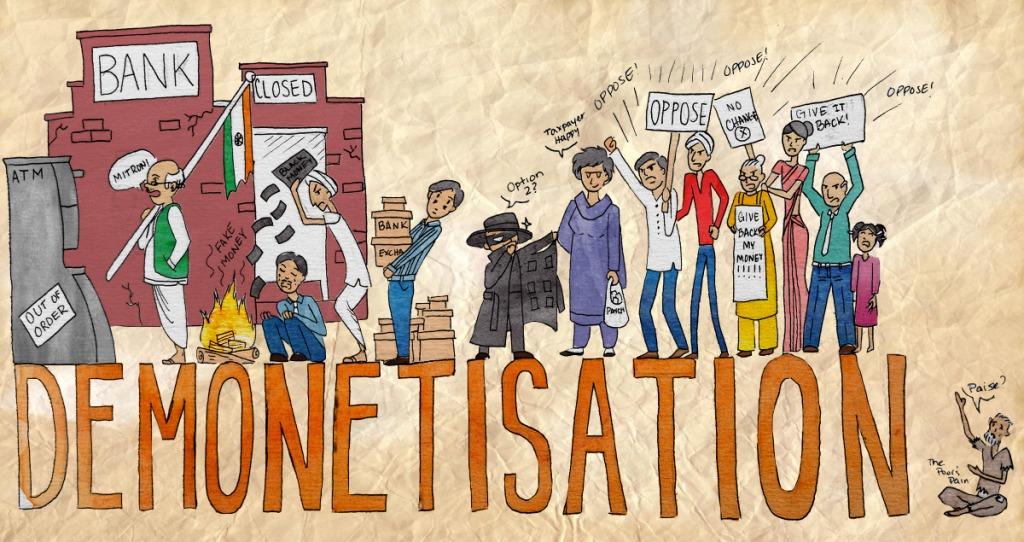Ahmedabad
(Head Office)Address : 506, 3rd EYE THREE (III), Opp. Induben Khakhrawala, Girish Cold Drink Cross Road, CG Road, Navrangpura, Ahmedabad, 380009.
Mobile : 8469231587 / 9586028957
Telephone : 079-40098991
E-mail: dics.upsc@gmail.com

Demonetisation
News: Recently, the Supreme Court has passed a verdict on the Demonetisation of currency notes of Rs 500 and Rs 1,000 in a majority 4-1 by a five-judge Constitution Bench.
What was the majority view of the verdict?
• The majority held that Centre’s notification dated November 8, 2016 is valid and satisfies the Test of proportionality.
• The RBI and the Centre had been in consultation with each other for six months prior to the November 8 notification issued under Section 26(2) of the RBI (Reserve Bank of India) Act, 1934.
• The statutory procedure under Section 26(2) of the RBI Act was not violated merely because the Centre had taken the initiative to “advice” the Central Board to consider recommending demonetisation.
• The government was empowered under the provision to demonetise “all series” of banknotes.
• On hasty decision, the court said such measures undisputedly are required to be taken with utmost confidentiality and speed. If the news of such a measure is leaked out, it is difficult to imagine how disastrous the consequences would be.
• Demonetisation was done for the “proper purposes” of eliminating fake currency, black money and terror financing.
What was the minority view?
• The government could have issued a notification under Section 26(2) of the RBI Act only if the RBI had initiated the proposal to demonetise by way of a recommendation. Therefore, the government's notification issued under Section 26(2) of the RBI Act was unlawful.
• In cases in which the government initiates demonetisation, it should take the opinion of the RBI. The opinion of the Board should be “independent and frank”. If the Board’s opinion was in the negative, the Centre could still go forward with the demonetisation exercise, but only by promulgating an ordinance or by enacting a parliamentary legislation.
• Describing the Parliament as the “nation in miniature”, “without the Parliament, democracy will not thrive”.
What is the Test of Proportionality?
• The test of proportionality is a commonly employed legal method used by courts around the world, typically constitutional courts, to decide cases where two or more legitimate rights clash. When such cases are decided, one right typically prevails at the expense of the other and the court thus has to balance the satisfaction of some rights and the damage to other rights resulting from a judgment.
• The principle of proportionality ordains that the administrative measure must not be more drastic than is necessary for attaining the desired result.

Address : 506, 3rd EYE THREE (III), Opp. Induben Khakhrawala, Girish Cold Drink Cross Road, CG Road, Navrangpura, Ahmedabad, 380009.
Mobile : 8469231587 / 9586028957
Telephone : 079-40098991
E-mail: dics.upsc@gmail.com
Address: A-306, The Landmark, Urjanagar-1, Opp. Spicy Street, Kudasan – Por Road, Kudasan, Gandhinagar – 382421
Mobile : 9723832444 / 9723932444
E-mail: dics.gnagar@gmail.com
Address: 2nd Floor, 9 Shivali Society, L&T Circle, opp. Ratri Bazar, Karelibaugh, Vadodara, 390018
Mobile : 9725692037 / 9725692054
E-mail: dics.vadodara@gmail.com
Address: 403, Raj Victoria, Opp. Pal Walkway, Near Galaxy Circle, Pal, Surat-394510
Mobile : 8401031583 / 8401031587
E-mail: dics.surat@gmail.com
Address: 303,305 K 158 Complex Above Magson, Sindhubhavan Road Ahmedabad-380059
Mobile : 9974751177 / 8469231587
E-mail: dicssbr@gmail.com
Address: 57/17, 2nd Floor, Old Rajinder Nagar Market, Bada Bazaar Marg, Delhi-60
Mobile : 9104830862 / 9104830865
E-mail: dics.newdelhi@gmail.com